CCS Technology and India's Energy Future: Challenges and Opportunities
VerifiedAdded on 2021/06/17
|21
|5883
|32
Report
AI Summary
This report provides a comprehensive overview of Carbon Capture and Storage (CCS) technology in India. It begins with an executive summary and introduction, followed by an analysis of the carbon dioxide situation in India, including emission levels and the country's large fossil fuel reserves. The report assesses current climate change policies and targets, alongside an examination of CCS activities, including projects undertaken by the Department of Science and Technology. It explores the impact of CCS on the energy system, technical developments, and the barriers to CCS technology in India, such as increased costs and energy deficits. The report also considers capacity development needs for successful CCS deployment and concludes with a view on the future of CCS in India, emphasizing the need for international cooperation. The report references various sources to support its findings, providing a detailed analysis of the challenges and opportunities associated with CCS implementation in India.
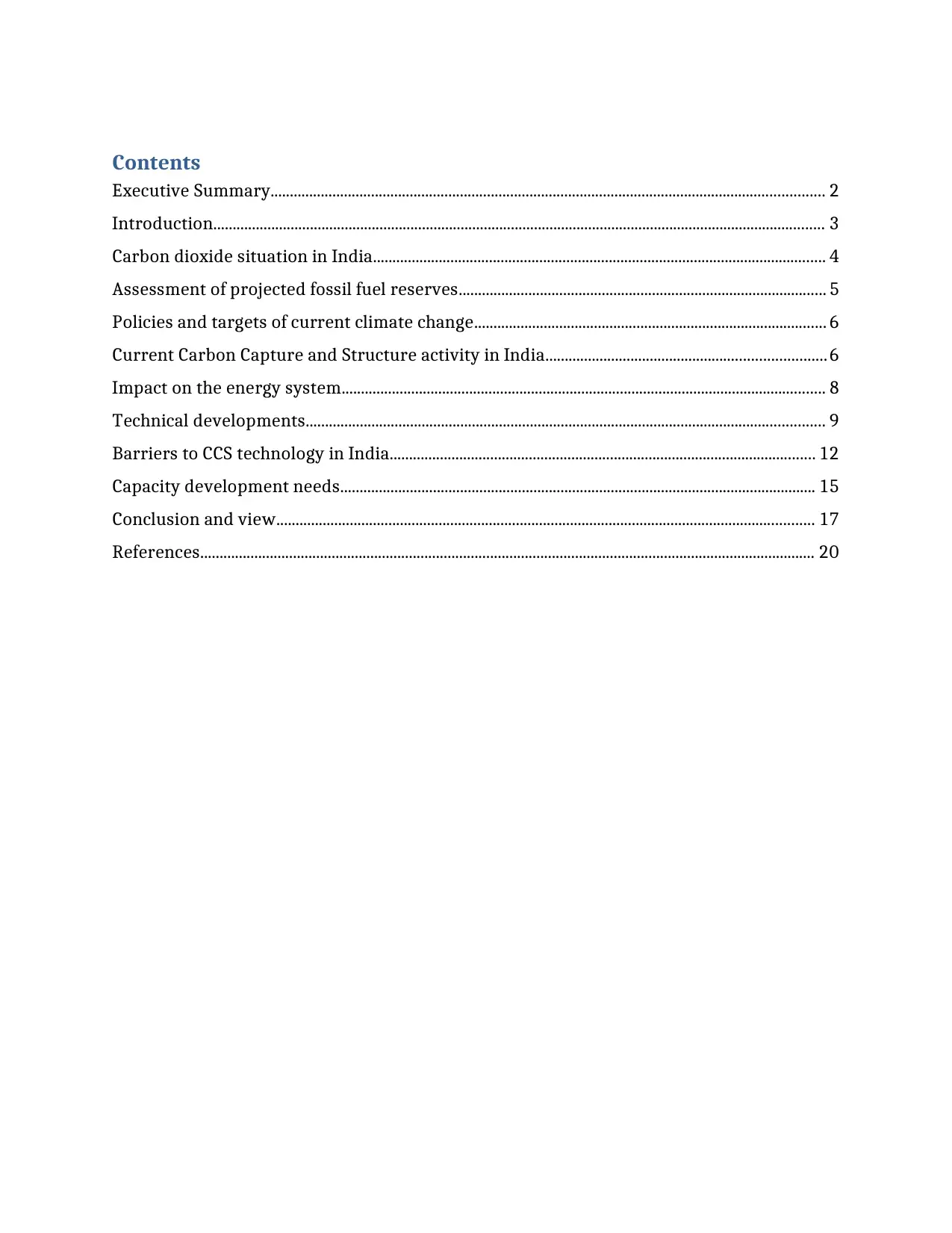
Contents
Executive Summary............................................................................................................................................... 2
Introduction.............................................................................................................................................................. 3
Carbon dioxide situation in India..................................................................................................................... 4
Assessment of projected fossil fuel reserves............................................................................................... 5
Policies and targets of current climate change........................................................................................... 6
Current Carbon Capture and Structure activity in India........................................................................6
Impact on the energy system............................................................................................................................. 8
Technical developments...................................................................................................................................... 9
Barriers to CCS technology in India.............................................................................................................. 12
Capacity development needs........................................................................................................................... 15
Conclusion and view........................................................................................................................................... 17
References............................................................................................................................................................... 20
Executive Summary............................................................................................................................................... 2
Introduction.............................................................................................................................................................. 3
Carbon dioxide situation in India..................................................................................................................... 4
Assessment of projected fossil fuel reserves............................................................................................... 5
Policies and targets of current climate change........................................................................................... 6
Current Carbon Capture and Structure activity in India........................................................................6
Impact on the energy system............................................................................................................................. 8
Technical developments...................................................................................................................................... 9
Barriers to CCS technology in India.............................................................................................................. 12
Capacity development needs........................................................................................................................... 15
Conclusion and view........................................................................................................................................... 17
References............................................................................................................................................................... 20
Paraphrase This Document
Need a fresh take? Get an instant paraphrase of this document with our AI Paraphraser

CARBON CAPTURE AND STRUCTURE, (CCS) IN INDIA
Executive Summary
Carbon Capture and Structure, the separation of carbon dioxide from energy-related and
industrial sources, transporting for storage and thus providing long-term isolation from the
atmosphere is one of the ways of reducing the concentration of carbon dioxide in the atmosphere.
India is one of the leading emitters of carbon dioxide by total emission due to its large reserves
of fossil fuels which form the primary source of energy. Deployment of CCS technology as a
climate change mitigation option aimed at achieving zero carbon emissions is still at
demonstration stage. There are numerous projects that are related to CCS technology in India
despite the caution with which the country approaches this technology citing various barriers and
challenges. Realization of success in the deployment of CCS technology calls for international
cooperation.
Executive Summary
Carbon Capture and Structure, the separation of carbon dioxide from energy-related and
industrial sources, transporting for storage and thus providing long-term isolation from the
atmosphere is one of the ways of reducing the concentration of carbon dioxide in the atmosphere.
India is one of the leading emitters of carbon dioxide by total emission due to its large reserves
of fossil fuels which form the primary source of energy. Deployment of CCS technology as a
climate change mitigation option aimed at achieving zero carbon emissions is still at
demonstration stage. There are numerous projects that are related to CCS technology in India
despite the caution with which the country approaches this technology citing various barriers and
challenges. Realization of success in the deployment of CCS technology calls for international
cooperation.
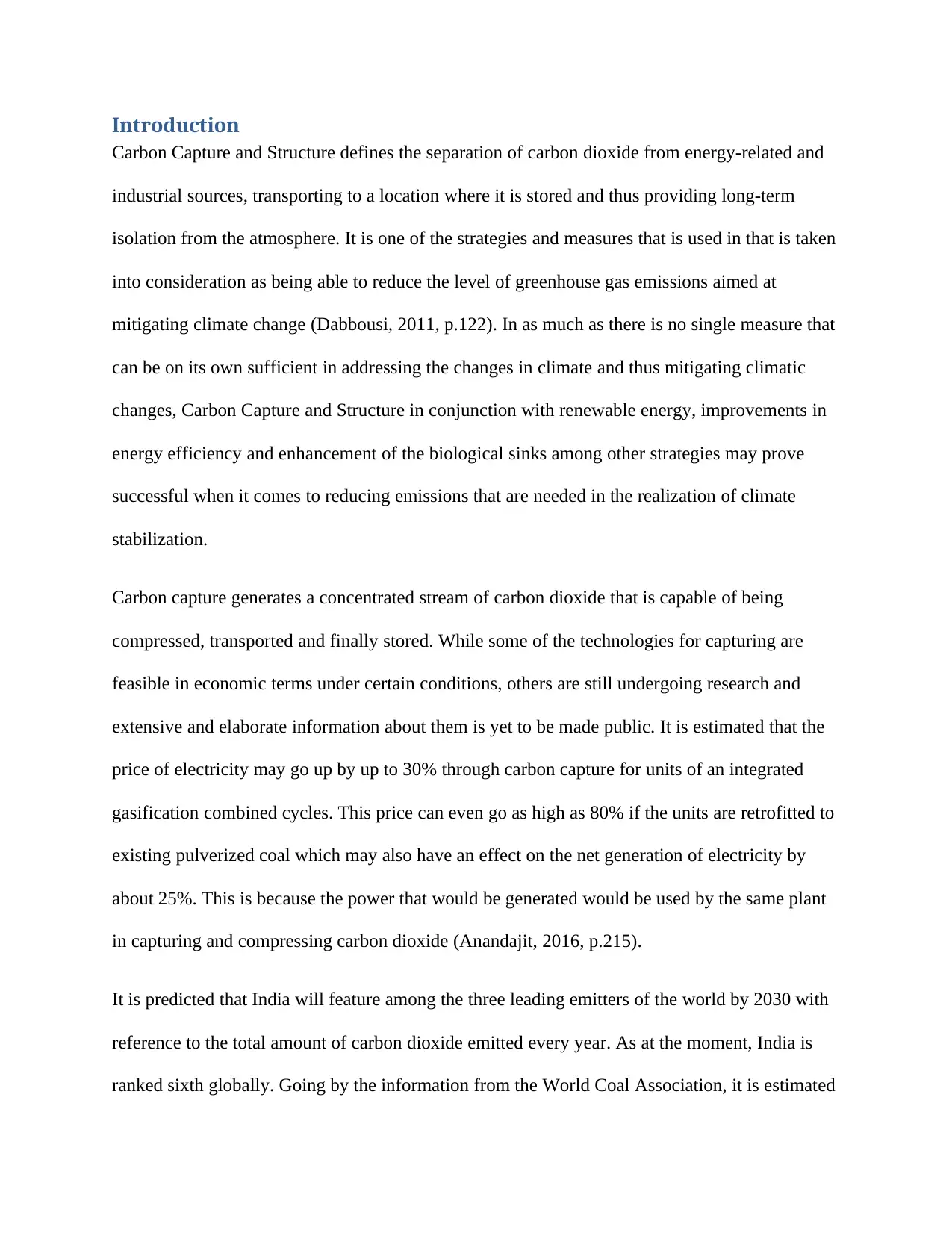
Introduction
Carbon Capture and Structure defines the separation of carbon dioxide from energy-related and
industrial sources, transporting to a location where it is stored and thus providing long-term
isolation from the atmosphere. It is one of the strategies and measures that is used in that is taken
into consideration as being able to reduce the level of greenhouse gas emissions aimed at
mitigating climate change (Dabbousi, 2011, p.122). In as much as there is no single measure that
can be on its own sufficient in addressing the changes in climate and thus mitigating climatic
changes, Carbon Capture and Structure in conjunction with renewable energy, improvements in
energy efficiency and enhancement of the biological sinks among other strategies may prove
successful when it comes to reducing emissions that are needed in the realization of climate
stabilization.
Carbon capture generates a concentrated stream of carbon dioxide that is capable of being
compressed, transported and finally stored. While some of the technologies for capturing are
feasible in economic terms under certain conditions, others are still undergoing research and
extensive and elaborate information about them is yet to be made public. It is estimated that the
price of electricity may go up by up to 30% through carbon capture for units of an integrated
gasification combined cycles. This price can even go as high as 80% if the units are retrofitted to
existing pulverized coal which may also have an effect on the net generation of electricity by
about 25%. This is because the power that would be generated would be used by the same plant
in capturing and compressing carbon dioxide (Anandajit, 2016, p.215).
It is predicted that India will feature among the three leading emitters of the world by 2030 with
reference to the total amount of carbon dioxide emitted every year. As at the moment, India is
ranked sixth globally. Going by the information from the World Coal Association, it is estimated
Carbon Capture and Structure defines the separation of carbon dioxide from energy-related and
industrial sources, transporting to a location where it is stored and thus providing long-term
isolation from the atmosphere. It is one of the strategies and measures that is used in that is taken
into consideration as being able to reduce the level of greenhouse gas emissions aimed at
mitigating climate change (Dabbousi, 2011, p.122). In as much as there is no single measure that
can be on its own sufficient in addressing the changes in climate and thus mitigating climatic
changes, Carbon Capture and Structure in conjunction with renewable energy, improvements in
energy efficiency and enhancement of the biological sinks among other strategies may prove
successful when it comes to reducing emissions that are needed in the realization of climate
stabilization.
Carbon capture generates a concentrated stream of carbon dioxide that is capable of being
compressed, transported and finally stored. While some of the technologies for capturing are
feasible in economic terms under certain conditions, others are still undergoing research and
extensive and elaborate information about them is yet to be made public. It is estimated that the
price of electricity may go up by up to 30% through carbon capture for units of an integrated
gasification combined cycles. This price can even go as high as 80% if the units are retrofitted to
existing pulverized coal which may also have an effect on the net generation of electricity by
about 25%. This is because the power that would be generated would be used by the same plant
in capturing and compressing carbon dioxide (Anandajit, 2016, p.215).
It is predicted that India will feature among the three leading emitters of the world by 2030 with
reference to the total amount of carbon dioxide emitted every year. As at the moment, India is
ranked sixth globally. Going by the information from the World Coal Association, it is estimated
⊘ This is a preview!⊘
Do you want full access?
Subscribe today to unlock all pages.

Trusted by 1+ million students worldwide
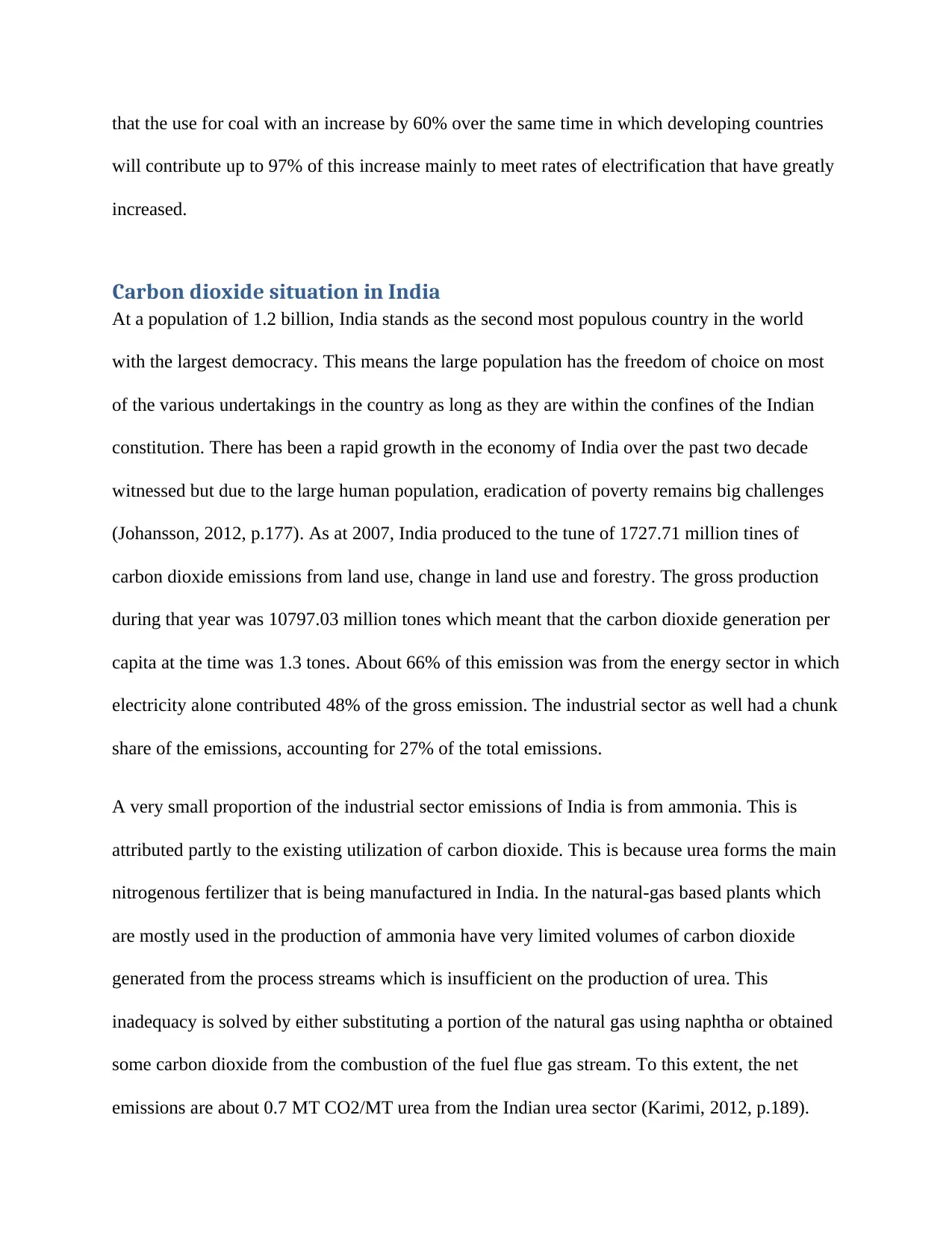
that the use for coal with an increase by 60% over the same time in which developing countries
will contribute up to 97% of this increase mainly to meet rates of electrification that have greatly
increased.
Carbon dioxide situation in India
At a population of 1.2 billion, India stands as the second most populous country in the world
with the largest democracy. This means the large population has the freedom of choice on most
of the various undertakings in the country as long as they are within the confines of the Indian
constitution. There has been a rapid growth in the economy of India over the past two decade
witnessed but due to the large human population, eradication of poverty remains big challenges
(Johansson, 2012, p.177). As at 2007, India produced to the tune of 1727.71 million tines of
carbon dioxide emissions from land use, change in land use and forestry. The gross production
during that year was 10797.03 million tones which meant that the carbon dioxide generation per
capita at the time was 1.3 tones. About 66% of this emission was from the energy sector in which
electricity alone contributed 48% of the gross emission. The industrial sector as well had a chunk
share of the emissions, accounting for 27% of the total emissions.
A very small proportion of the industrial sector emissions of India is from ammonia. This is
attributed partly to the existing utilization of carbon dioxide. This is because urea forms the main
nitrogenous fertilizer that is being manufactured in India. In the natural-gas based plants which
are mostly used in the production of ammonia have very limited volumes of carbon dioxide
generated from the process streams which is insufficient on the production of urea. This
inadequacy is solved by either substituting a portion of the natural gas using naphtha or obtained
some carbon dioxide from the combustion of the fuel flue gas stream. To this extent, the net
emissions are about 0.7 MT CO2/MT urea from the Indian urea sector (Karimi, 2012, p.189).
will contribute up to 97% of this increase mainly to meet rates of electrification that have greatly
increased.
Carbon dioxide situation in India
At a population of 1.2 billion, India stands as the second most populous country in the world
with the largest democracy. This means the large population has the freedom of choice on most
of the various undertakings in the country as long as they are within the confines of the Indian
constitution. There has been a rapid growth in the economy of India over the past two decade
witnessed but due to the large human population, eradication of poverty remains big challenges
(Johansson, 2012, p.177). As at 2007, India produced to the tune of 1727.71 million tines of
carbon dioxide emissions from land use, change in land use and forestry. The gross production
during that year was 10797.03 million tones which meant that the carbon dioxide generation per
capita at the time was 1.3 tones. About 66% of this emission was from the energy sector in which
electricity alone contributed 48% of the gross emission. The industrial sector as well had a chunk
share of the emissions, accounting for 27% of the total emissions.
A very small proportion of the industrial sector emissions of India is from ammonia. This is
attributed partly to the existing utilization of carbon dioxide. This is because urea forms the main
nitrogenous fertilizer that is being manufactured in India. In the natural-gas based plants which
are mostly used in the production of ammonia have very limited volumes of carbon dioxide
generated from the process streams which is insufficient on the production of urea. This
inadequacy is solved by either substituting a portion of the natural gas using naphtha or obtained
some carbon dioxide from the combustion of the fuel flue gas stream. To this extent, the net
emissions are about 0.7 MT CO2/MT urea from the Indian urea sector (Karimi, 2012, p.189).
Paraphrase This Document
Need a fresh take? Get an instant paraphrase of this document with our AI Paraphraser
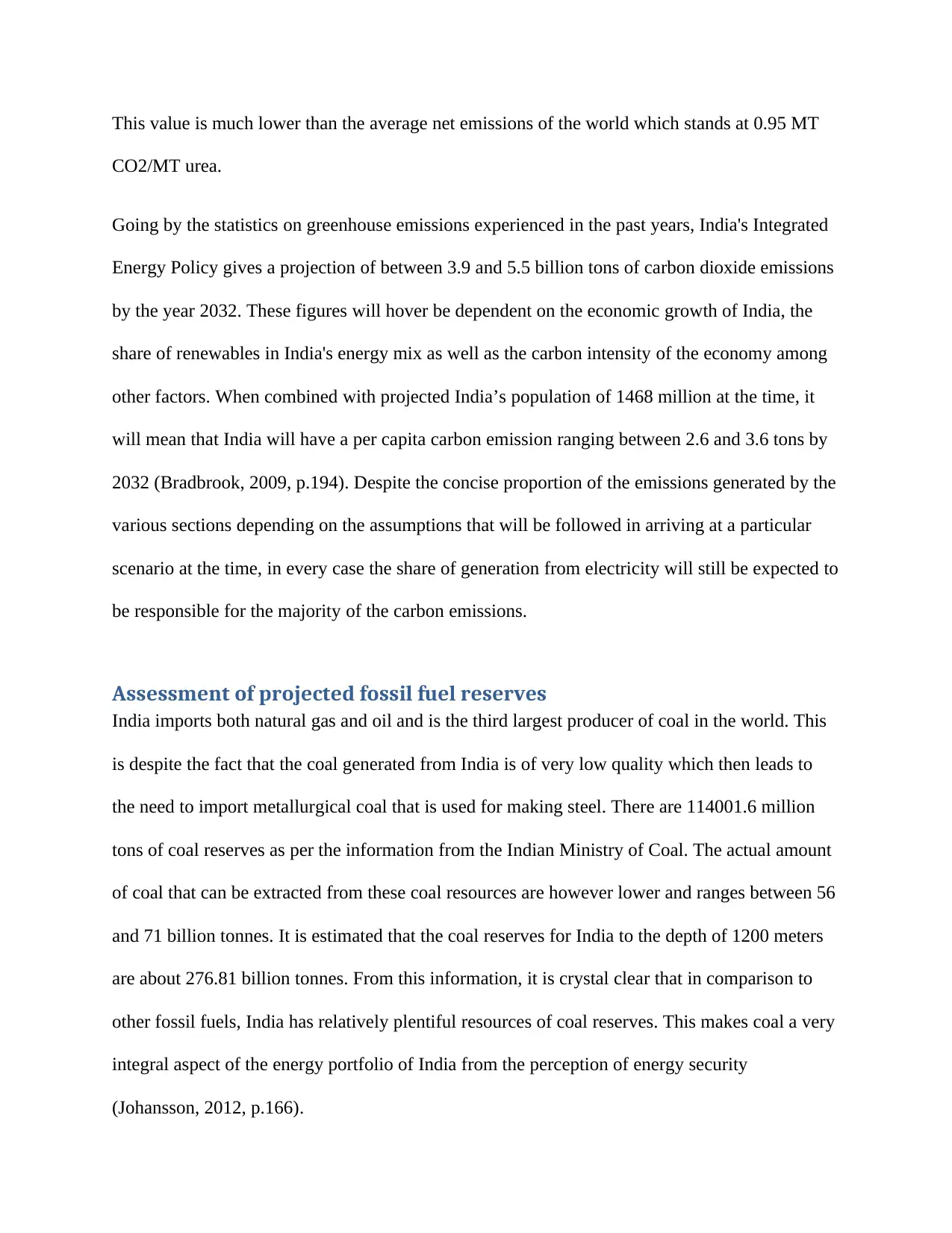
This value is much lower than the average net emissions of the world which stands at 0.95 MT
CO2/MT urea.
Going by the statistics on greenhouse emissions experienced in the past years, India's Integrated
Energy Policy gives a projection of between 3.9 and 5.5 billion tons of carbon dioxide emissions
by the year 2032. These figures will hover be dependent on the economic growth of India, the
share of renewables in India's energy mix as well as the carbon intensity of the economy among
other factors. When combined with projected India’s population of 1468 million at the time, it
will mean that India will have a per capita carbon emission ranging between 2.6 and 3.6 tons by
2032 (Bradbrook, 2009, p.194). Despite the concise proportion of the emissions generated by the
various sections depending on the assumptions that will be followed in arriving at a particular
scenario at the time, in every case the share of generation from electricity will still be expected to
be responsible for the majority of the carbon emissions.
Assessment of projected fossil fuel reserves
India imports both natural gas and oil and is the third largest producer of coal in the world. This
is despite the fact that the coal generated from India is of very low quality which then leads to
the need to import metallurgical coal that is used for making steel. There are 114001.6 million
tons of coal reserves as per the information from the Indian Ministry of Coal. The actual amount
of coal that can be extracted from these coal resources are however lower and ranges between 56
and 71 billion tonnes. It is estimated that the coal reserves for India to the depth of 1200 meters
are about 276.81 billion tonnes. From this information, it is crystal clear that in comparison to
other fossil fuels, India has relatively plentiful resources of coal reserves. This makes coal a very
integral aspect of the energy portfolio of India from the perception of energy security
(Johansson, 2012, p.166).
CO2/MT urea.
Going by the statistics on greenhouse emissions experienced in the past years, India's Integrated
Energy Policy gives a projection of between 3.9 and 5.5 billion tons of carbon dioxide emissions
by the year 2032. These figures will hover be dependent on the economic growth of India, the
share of renewables in India's energy mix as well as the carbon intensity of the economy among
other factors. When combined with projected India’s population of 1468 million at the time, it
will mean that India will have a per capita carbon emission ranging between 2.6 and 3.6 tons by
2032 (Bradbrook, 2009, p.194). Despite the concise proportion of the emissions generated by the
various sections depending on the assumptions that will be followed in arriving at a particular
scenario at the time, in every case the share of generation from electricity will still be expected to
be responsible for the majority of the carbon emissions.
Assessment of projected fossil fuel reserves
India imports both natural gas and oil and is the third largest producer of coal in the world. This
is despite the fact that the coal generated from India is of very low quality which then leads to
the need to import metallurgical coal that is used for making steel. There are 114001.6 million
tons of coal reserves as per the information from the Indian Ministry of Coal. The actual amount
of coal that can be extracted from these coal resources are however lower and ranges between 56
and 71 billion tonnes. It is estimated that the coal reserves for India to the depth of 1200 meters
are about 276.81 billion tonnes. From this information, it is crystal clear that in comparison to
other fossil fuels, India has relatively plentiful resources of coal reserves. This makes coal a very
integral aspect of the energy portfolio of India from the perception of energy security
(Johansson, 2012, p.166).
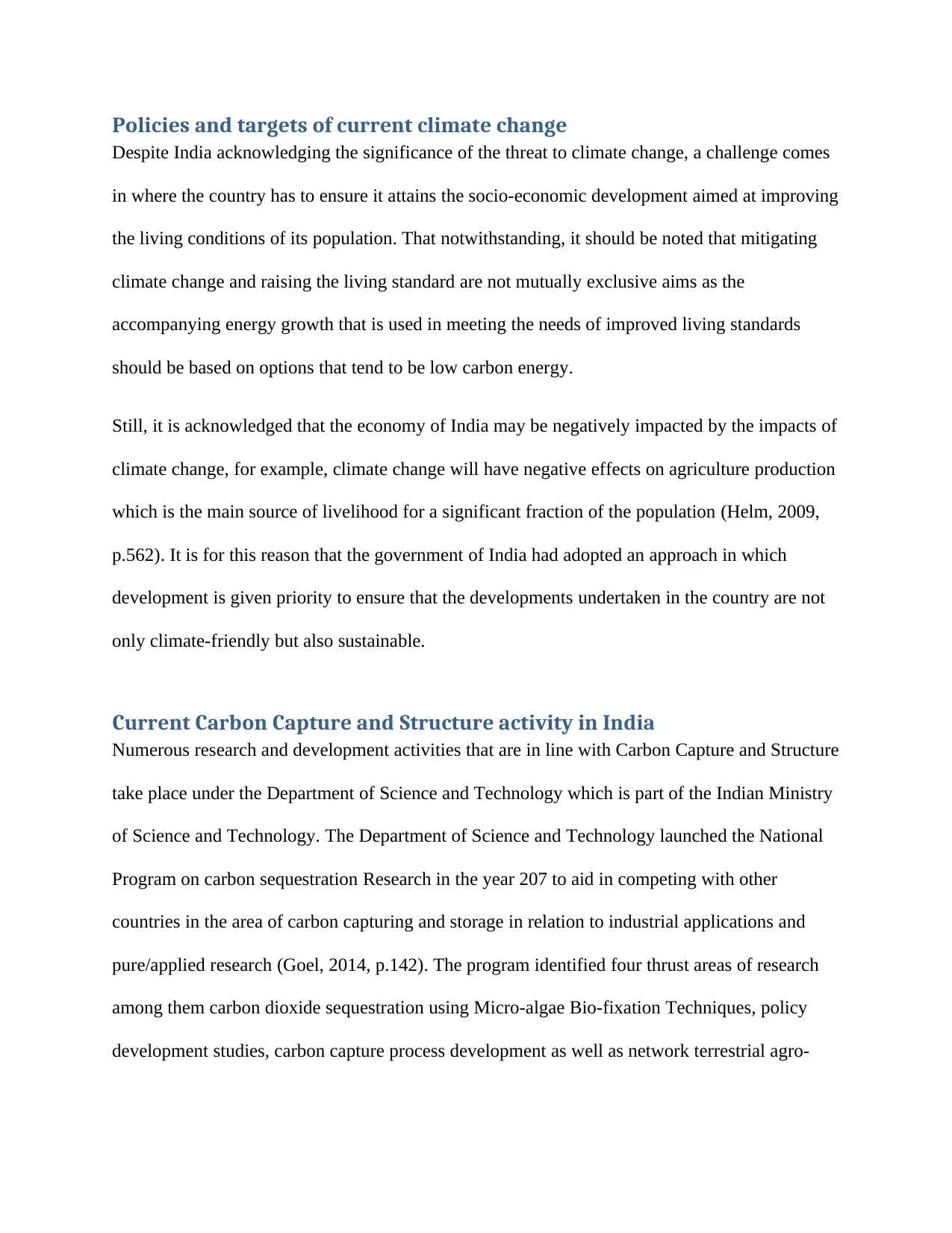
Policies and targets of current climate change
Despite India acknowledging the significance of the threat to climate change, a challenge comes
in where the country has to ensure it attains the socio-economic development aimed at improving
the living conditions of its population. That notwithstanding, it should be noted that mitigating
climate change and raising the living standard are not mutually exclusive aims as the
accompanying energy growth that is used in meeting the needs of improved living standards
should be based on options that tend to be low carbon energy.
Still, it is acknowledged that the economy of India may be negatively impacted by the impacts of
climate change, for example, climate change will have negative effects on agriculture production
which is the main source of livelihood for a significant fraction of the population (Helm, 2009,
p.562). It is for this reason that the government of India had adopted an approach in which
development is given priority to ensure that the developments undertaken in the country are not
only climate-friendly but also sustainable.
Current Carbon Capture and Structure activity in India
Numerous research and development activities that are in line with Carbon Capture and Structure
take place under the Department of Science and Technology which is part of the Indian Ministry
of Science and Technology. The Department of Science and Technology launched the National
Program on carbon sequestration Research in the year 207 to aid in competing with other
countries in the area of carbon capturing and storage in relation to industrial applications and
pure/applied research (Goel, 2014, p.142). The program identified four thrust areas of research
among them carbon dioxide sequestration using Micro-algae Bio-fixation Techniques, policy
development studies, carbon capture process development as well as network terrestrial agro-
Despite India acknowledging the significance of the threat to climate change, a challenge comes
in where the country has to ensure it attains the socio-economic development aimed at improving
the living conditions of its population. That notwithstanding, it should be noted that mitigating
climate change and raising the living standard are not mutually exclusive aims as the
accompanying energy growth that is used in meeting the needs of improved living standards
should be based on options that tend to be low carbon energy.
Still, it is acknowledged that the economy of India may be negatively impacted by the impacts of
climate change, for example, climate change will have negative effects on agriculture production
which is the main source of livelihood for a significant fraction of the population (Helm, 2009,
p.562). It is for this reason that the government of India had adopted an approach in which
development is given priority to ensure that the developments undertaken in the country are not
only climate-friendly but also sustainable.
Current Carbon Capture and Structure activity in India
Numerous research and development activities that are in line with Carbon Capture and Structure
take place under the Department of Science and Technology which is part of the Indian Ministry
of Science and Technology. The Department of Science and Technology launched the National
Program on carbon sequestration Research in the year 207 to aid in competing with other
countries in the area of carbon capturing and storage in relation to industrial applications and
pure/applied research (Goel, 2014, p.142). The program identified four thrust areas of research
among them carbon dioxide sequestration using Micro-algae Bio-fixation Techniques, policy
development studies, carbon capture process development as well as network terrestrial agro-
⊘ This is a preview!⊘
Do you want full access?
Subscribe today to unlock all pages.

Trusted by 1+ million students worldwide
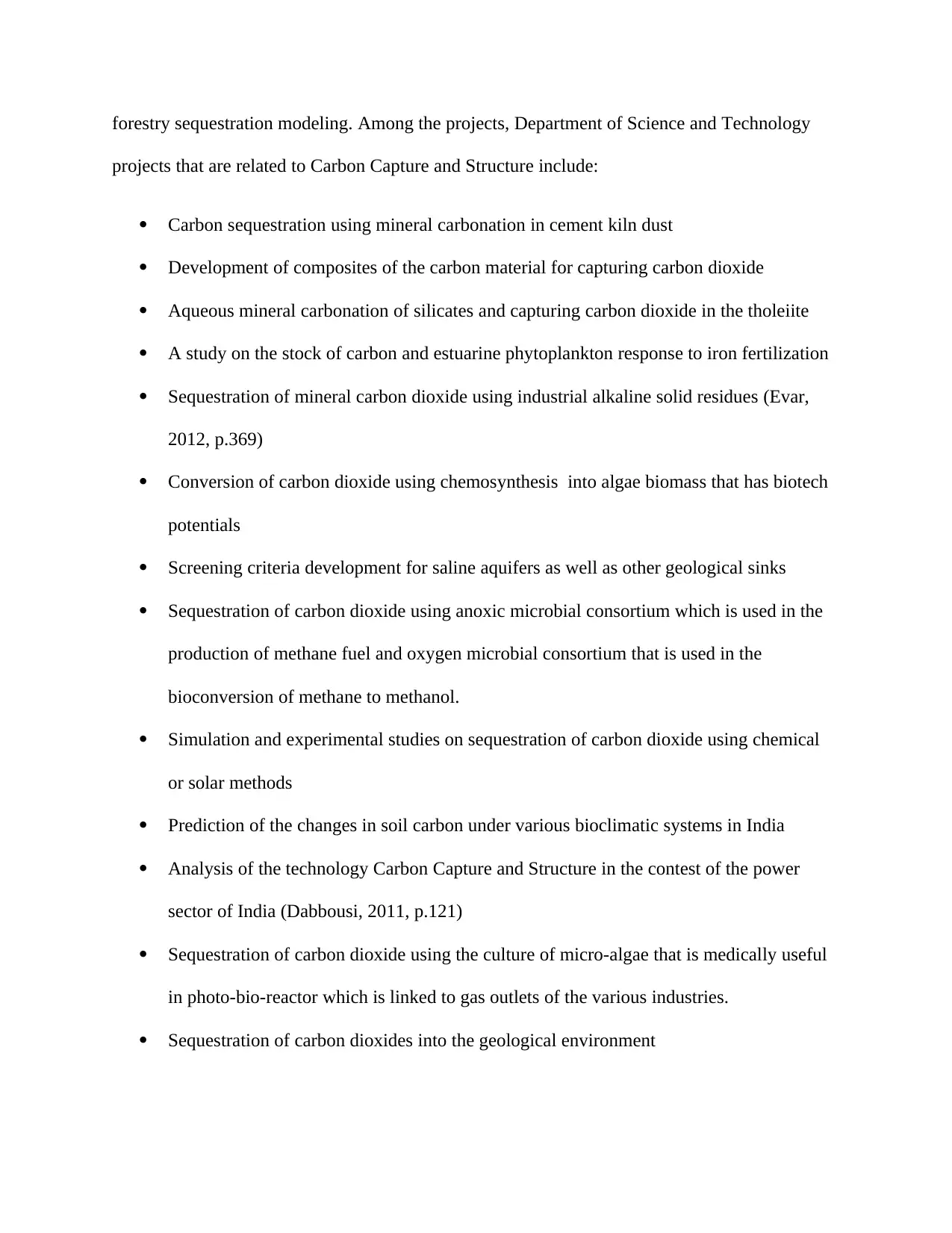
forestry sequestration modeling. Among the projects, Department of Science and Technology
projects that are related to Carbon Capture and Structure include:
Carbon sequestration using mineral carbonation in cement kiln dust
Development of composites of the carbon material for capturing carbon dioxide
Aqueous mineral carbonation of silicates and capturing carbon dioxide in the tholeiite
A study on the stock of carbon and estuarine phytoplankton response to iron fertilization
Sequestration of mineral carbon dioxide using industrial alkaline solid residues (Evar,
2012, p.369)
Conversion of carbon dioxide using chemosynthesis into algae biomass that has biotech
potentials
Screening criteria development for saline aquifers as well as other geological sinks
Sequestration of carbon dioxide using anoxic microbial consortium which is used in the
production of methane fuel and oxygen microbial consortium that is used in the
bioconversion of methane to methanol.
Simulation and experimental studies on sequestration of carbon dioxide using chemical
or solar methods
Prediction of the changes in soil carbon under various bioclimatic systems in India
Analysis of the technology Carbon Capture and Structure in the contest of the power
sector of India (Dabbousi, 2011, p.121)
Sequestration of carbon dioxide using the culture of micro-algae that is medically useful
in photo-bio-reactor which is linked to gas outlets of the various industries.
Sequestration of carbon dioxides into the geological environment
projects that are related to Carbon Capture and Structure include:
Carbon sequestration using mineral carbonation in cement kiln dust
Development of composites of the carbon material for capturing carbon dioxide
Aqueous mineral carbonation of silicates and capturing carbon dioxide in the tholeiite
A study on the stock of carbon and estuarine phytoplankton response to iron fertilization
Sequestration of mineral carbon dioxide using industrial alkaline solid residues (Evar,
2012, p.369)
Conversion of carbon dioxide using chemosynthesis into algae biomass that has biotech
potentials
Screening criteria development for saline aquifers as well as other geological sinks
Sequestration of carbon dioxide using anoxic microbial consortium which is used in the
production of methane fuel and oxygen microbial consortium that is used in the
bioconversion of methane to methanol.
Simulation and experimental studies on sequestration of carbon dioxide using chemical
or solar methods
Prediction of the changes in soil carbon under various bioclimatic systems in India
Analysis of the technology Carbon Capture and Structure in the contest of the power
sector of India (Dabbousi, 2011, p.121)
Sequestration of carbon dioxide using the culture of micro-algae that is medically useful
in photo-bio-reactor which is linked to gas outlets of the various industries.
Sequestration of carbon dioxides into the geological environment
Paraphrase This Document
Need a fresh take? Get an instant paraphrase of this document with our AI Paraphraser
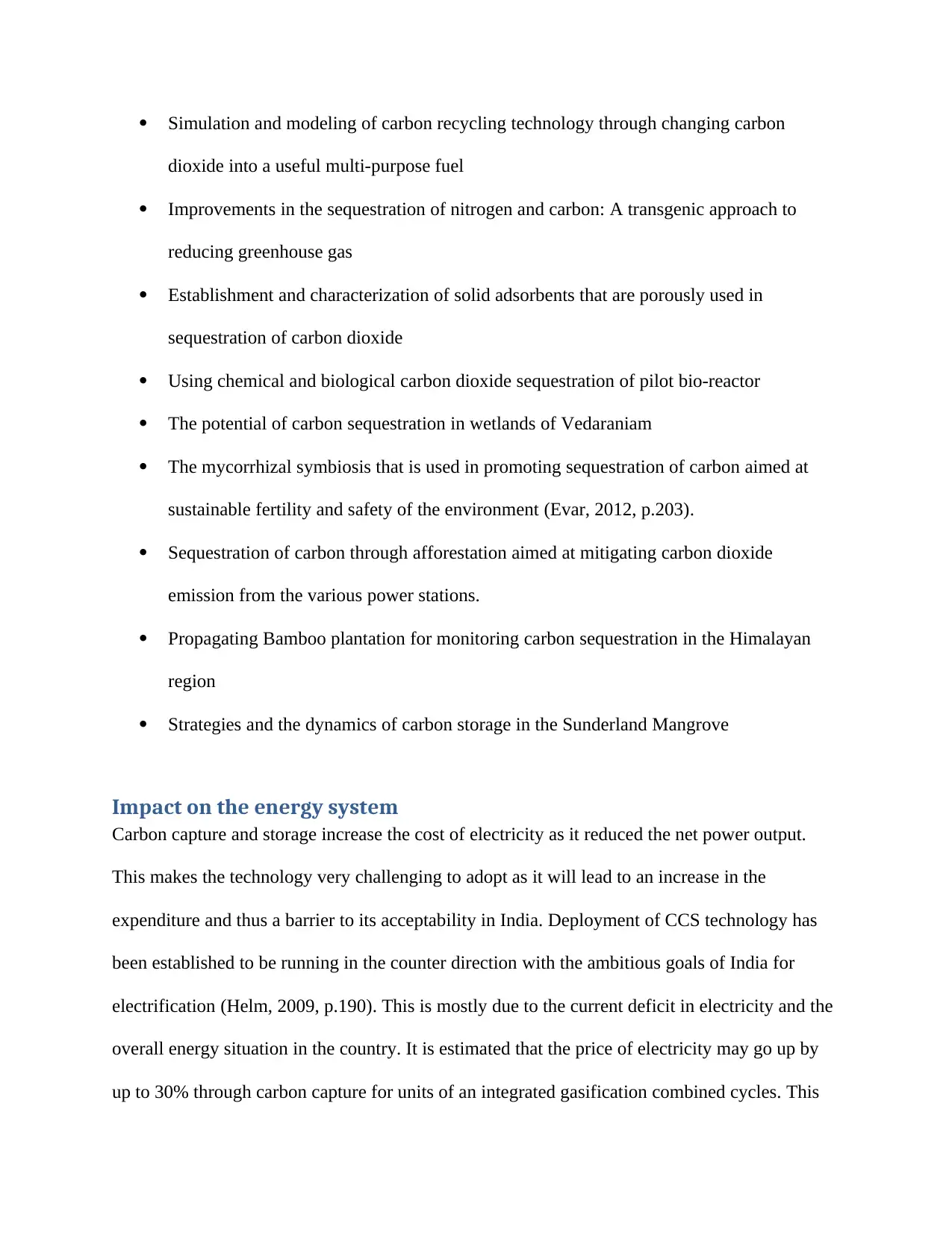
Simulation and modeling of carbon recycling technology through changing carbon
dioxide into a useful multi-purpose fuel
Improvements in the sequestration of nitrogen and carbon: A transgenic approach to
reducing greenhouse gas
Establishment and characterization of solid adsorbents that are porously used in
sequestration of carbon dioxide
Using chemical and biological carbon dioxide sequestration of pilot bio-reactor
The potential of carbon sequestration in wetlands of Vedaraniam
The mycorrhizal symbiosis that is used in promoting sequestration of carbon aimed at
sustainable fertility and safety of the environment (Evar, 2012, p.203).
Sequestration of carbon through afforestation aimed at mitigating carbon dioxide
emission from the various power stations.
Propagating Bamboo plantation for monitoring carbon sequestration in the Himalayan
region
Strategies and the dynamics of carbon storage in the Sunderland Mangrove
Impact on the energy system
Carbon capture and storage increase the cost of electricity as it reduced the net power output.
This makes the technology very challenging to adopt as it will lead to an increase in the
expenditure and thus a barrier to its acceptability in India. Deployment of CCS technology has
been established to be running in the counter direction with the ambitious goals of India for
electrification (Helm, 2009, p.190). This is mostly due to the current deficit in electricity and the
overall energy situation in the country. It is estimated that the price of electricity may go up by
up to 30% through carbon capture for units of an integrated gasification combined cycles. This
dioxide into a useful multi-purpose fuel
Improvements in the sequestration of nitrogen and carbon: A transgenic approach to
reducing greenhouse gas
Establishment and characterization of solid adsorbents that are porously used in
sequestration of carbon dioxide
Using chemical and biological carbon dioxide sequestration of pilot bio-reactor
The potential of carbon sequestration in wetlands of Vedaraniam
The mycorrhizal symbiosis that is used in promoting sequestration of carbon aimed at
sustainable fertility and safety of the environment (Evar, 2012, p.203).
Sequestration of carbon through afforestation aimed at mitigating carbon dioxide
emission from the various power stations.
Propagating Bamboo plantation for monitoring carbon sequestration in the Himalayan
region
Strategies and the dynamics of carbon storage in the Sunderland Mangrove
Impact on the energy system
Carbon capture and storage increase the cost of electricity as it reduced the net power output.
This makes the technology very challenging to adopt as it will lead to an increase in the
expenditure and thus a barrier to its acceptability in India. Deployment of CCS technology has
been established to be running in the counter direction with the ambitious goals of India for
electrification (Helm, 2009, p.190). This is mostly due to the current deficit in electricity and the
overall energy situation in the country. It is estimated that the price of electricity may go up by
up to 30% through carbon capture for units of an integrated gasification combined cycles. This
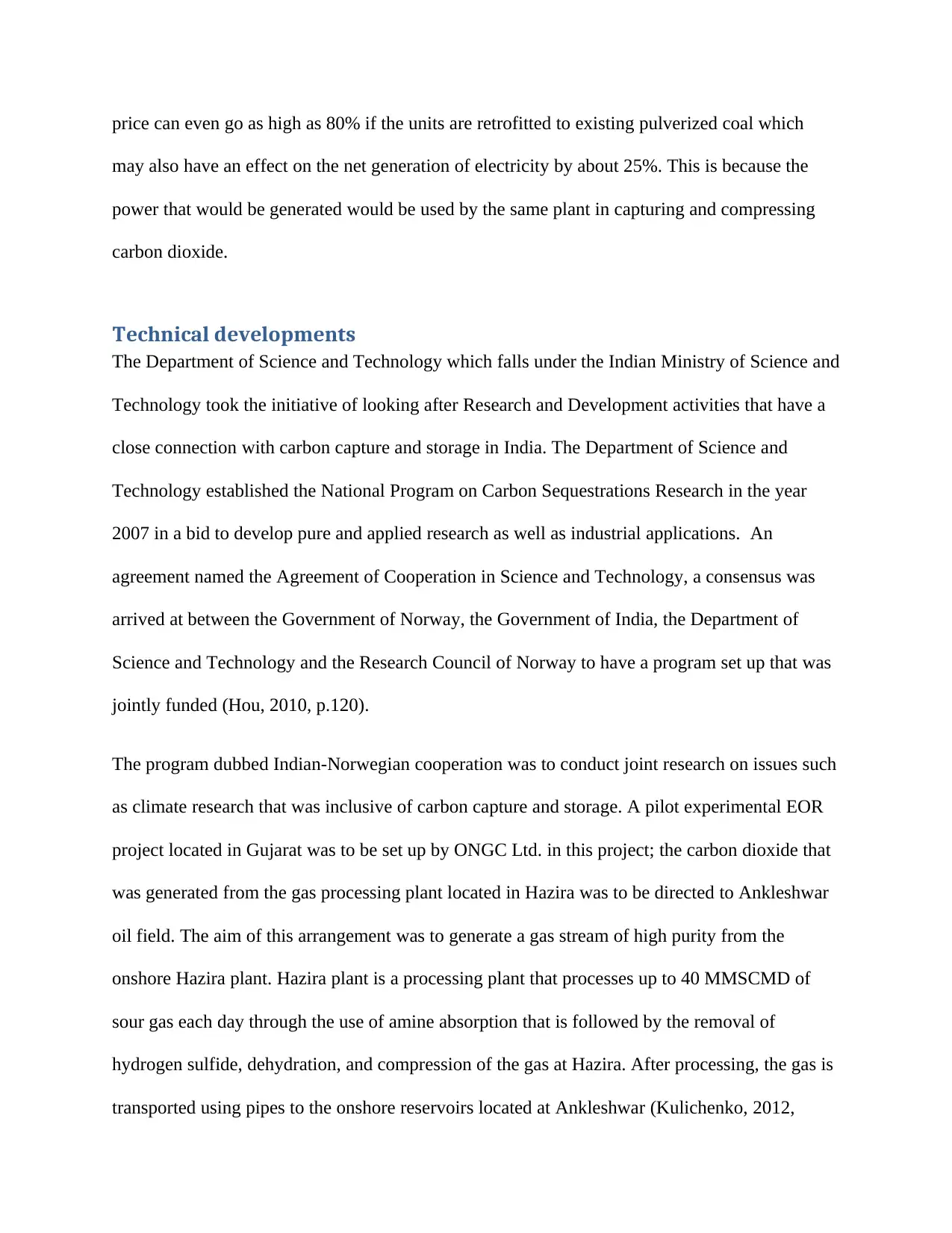
price can even go as high as 80% if the units are retrofitted to existing pulverized coal which
may also have an effect on the net generation of electricity by about 25%. This is because the
power that would be generated would be used by the same plant in capturing and compressing
carbon dioxide.
Technical developments
The Department of Science and Technology which falls under the Indian Ministry of Science and
Technology took the initiative of looking after Research and Development activities that have a
close connection with carbon capture and storage in India. The Department of Science and
Technology established the National Program on Carbon Sequestrations Research in the year
2007 in a bid to develop pure and applied research as well as industrial applications. An
agreement named the Agreement of Cooperation in Science and Technology, a consensus was
arrived at between the Government of Norway, the Government of India, the Department of
Science and Technology and the Research Council of Norway to have a program set up that was
jointly funded (Hou, 2010, p.120).
The program dubbed Indian-Norwegian cooperation was to conduct joint research on issues such
as climate research that was inclusive of carbon capture and storage. A pilot experimental EOR
project located in Gujarat was to be set up by ONGC Ltd. in this project; the carbon dioxide that
was generated from the gas processing plant located in Hazira was to be directed to Ankleshwar
oil field. The aim of this arrangement was to generate a gas stream of high purity from the
onshore Hazira plant. Hazira plant is a processing plant that processes up to 40 MMSCMD of
sour gas each day through the use of amine absorption that is followed by the removal of
hydrogen sulfide, dehydration, and compression of the gas at Hazira. After processing, the gas is
transported using pipes to the onshore reservoirs located at Ankleshwar (Kulichenko, 2012,
may also have an effect on the net generation of electricity by about 25%. This is because the
power that would be generated would be used by the same plant in capturing and compressing
carbon dioxide.
Technical developments
The Department of Science and Technology which falls under the Indian Ministry of Science and
Technology took the initiative of looking after Research and Development activities that have a
close connection with carbon capture and storage in India. The Department of Science and
Technology established the National Program on Carbon Sequestrations Research in the year
2007 in a bid to develop pure and applied research as well as industrial applications. An
agreement named the Agreement of Cooperation in Science and Technology, a consensus was
arrived at between the Government of Norway, the Government of India, the Department of
Science and Technology and the Research Council of Norway to have a program set up that was
jointly funded (Hou, 2010, p.120).
The program dubbed Indian-Norwegian cooperation was to conduct joint research on issues such
as climate research that was inclusive of carbon capture and storage. A pilot experimental EOR
project located in Gujarat was to be set up by ONGC Ltd. in this project; the carbon dioxide that
was generated from the gas processing plant located in Hazira was to be directed to Ankleshwar
oil field. The aim of this arrangement was to generate a gas stream of high purity from the
onshore Hazira plant. Hazira plant is a processing plant that processes up to 40 MMSCMD of
sour gas each day through the use of amine absorption that is followed by the removal of
hydrogen sulfide, dehydration, and compression of the gas at Hazira. After processing, the gas is
transported using pipes to the onshore reservoirs located at Ankleshwar (Kulichenko, 2012,
⊘ This is a preview!⊘
Do you want full access?
Subscribe today to unlock all pages.

Trusted by 1+ million students worldwide
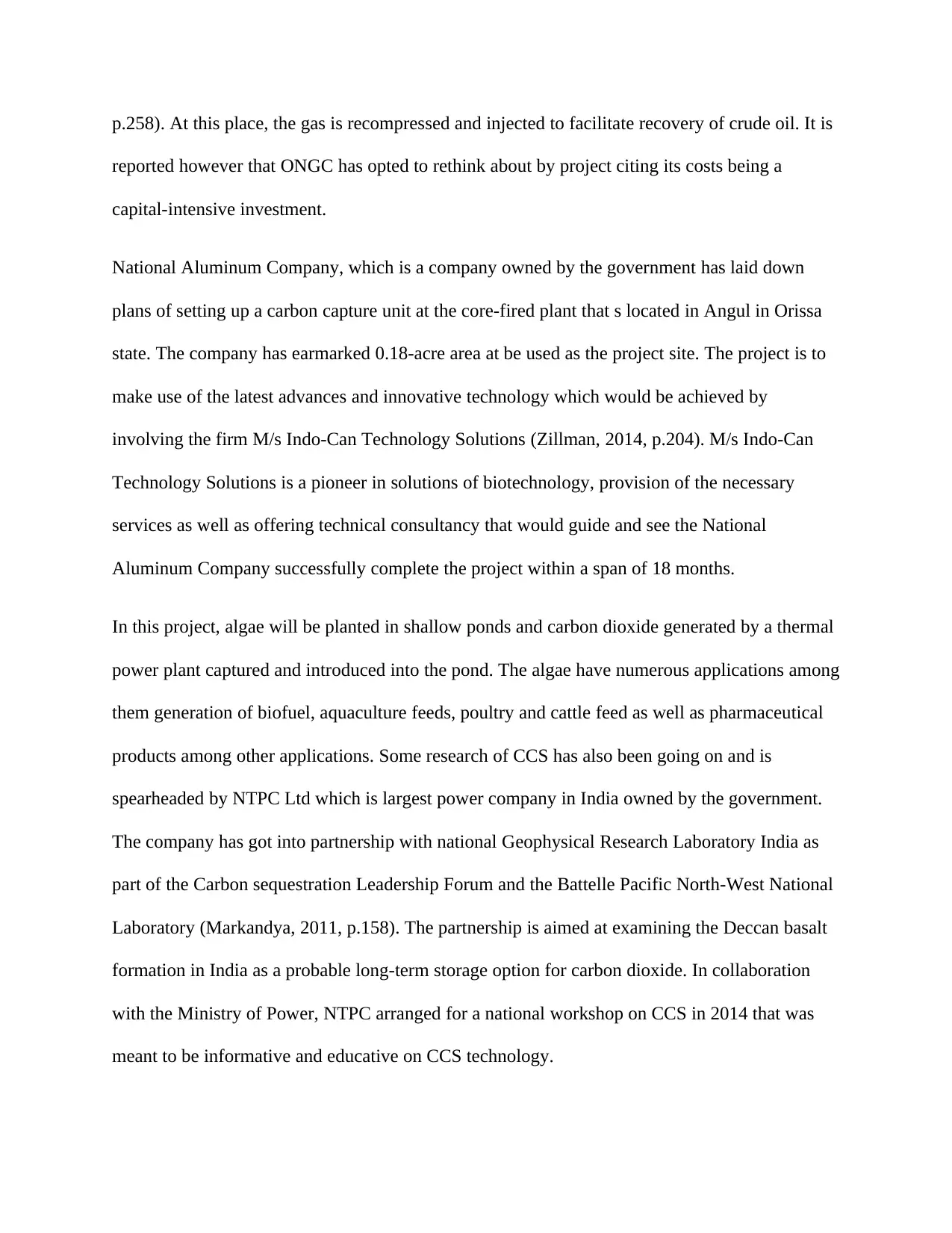
p.258). At this place, the gas is recompressed and injected to facilitate recovery of crude oil. It is
reported however that ONGC has opted to rethink about by project citing its costs being a
capital-intensive investment.
National Aluminum Company, which is a company owned by the government has laid down
plans of setting up a carbon capture unit at the core-fired plant that s located in Angul in Orissa
state. The company has earmarked 0.18-acre area at be used as the project site. The project is to
make use of the latest advances and innovative technology which would be achieved by
involving the firm M/s Indo-Can Technology Solutions (Zillman, 2014, p.204). M/s Indo-Can
Technology Solutions is a pioneer in solutions of biotechnology, provision of the necessary
services as well as offering technical consultancy that would guide and see the National
Aluminum Company successfully complete the project within a span of 18 months.
In this project, algae will be planted in shallow ponds and carbon dioxide generated by a thermal
power plant captured and introduced into the pond. The algae have numerous applications among
them generation of biofuel, aquaculture feeds, poultry and cattle feed as well as pharmaceutical
products among other applications. Some research of CCS has also been going on and is
spearheaded by NTPC Ltd which is largest power company in India owned by the government.
The company has got into partnership with national Geophysical Research Laboratory India as
part of the Carbon sequestration Leadership Forum and the Battelle Pacific North-West National
Laboratory (Markandya, 2011, p.158). The partnership is aimed at examining the Deccan basalt
formation in India as a probable long-term storage option for carbon dioxide. In collaboration
with the Ministry of Power, NTPC arranged for a national workshop on CCS in 2014 that was
meant to be informative and educative on CCS technology.
reported however that ONGC has opted to rethink about by project citing its costs being a
capital-intensive investment.
National Aluminum Company, which is a company owned by the government has laid down
plans of setting up a carbon capture unit at the core-fired plant that s located in Angul in Orissa
state. The company has earmarked 0.18-acre area at be used as the project site. The project is to
make use of the latest advances and innovative technology which would be achieved by
involving the firm M/s Indo-Can Technology Solutions (Zillman, 2014, p.204). M/s Indo-Can
Technology Solutions is a pioneer in solutions of biotechnology, provision of the necessary
services as well as offering technical consultancy that would guide and see the National
Aluminum Company successfully complete the project within a span of 18 months.
In this project, algae will be planted in shallow ponds and carbon dioxide generated by a thermal
power plant captured and introduced into the pond. The algae have numerous applications among
them generation of biofuel, aquaculture feeds, poultry and cattle feed as well as pharmaceutical
products among other applications. Some research of CCS has also been going on and is
spearheaded by NTPC Ltd which is largest power company in India owned by the government.
The company has got into partnership with national Geophysical Research Laboratory India as
part of the Carbon sequestration Leadership Forum and the Battelle Pacific North-West National
Laboratory (Markandya, 2011, p.158). The partnership is aimed at examining the Deccan basalt
formation in India as a probable long-term storage option for carbon dioxide. In collaboration
with the Ministry of Power, NTPC arranged for a national workshop on CCS in 2014 that was
meant to be informative and educative on CCS technology.
Paraphrase This Document
Need a fresh take? Get an instant paraphrase of this document with our AI Paraphraser

Work is going on in the development of new adsorbents for post-combustion carbon dioxide
capture. This is an undertaking by the Indian Institute of Petroleum. In this light, a three column
Pressure Swing Adsorption/Vacuum Swing Adoption unit has been set up in by the institute in
their laboratory located in Dehradun (Rand, 2010, p.278). Testing is being undertaken in these
columns under flue gas conditions as is available in power plants. The work is being done in
conjunction with IIT Bombay that performs the simulation and process design aspects, National
Environmental Engineering Institute and the Central Salt and Marine Chemicals Research
Institute who are handling adsorbent development as well as NTPC which is in charge of
operation of the power plants.
An engineering and manufacturing enterprise that is owned by the government named Bharat
Heavy Electrical Ltd. in collaboration with APGENCO which is the company that generated
power in Andhra Pradesh is establishing a demonstration plant. The plant which operates at 125
W is located in Andhra Pradesh. This plant is however not directly related to CCS even though it
has been found to one of the most affordable options for capturing carbon. Deployment of this
technology has challenges when it comes to implementing it for Indian coal as there are
arguments that the development may finally lead to the deployment of pre-combustion capture
technology in India's power sector (Schuler, 2014, p.234).
Besides establishing the first IGCC plant in India, Bharat Heavy Electrical Ltd is also working in
collaboration with India Gandhi Center for Atomic Research and NTPC. The collaboration is
aimed at design, developing and construction boilers which are ultra-super-critical in nature. The
boilers will be supplementary to the supercritical technology boilers that are already being
manufactured (Cook, 2018, p.184). There is also collaboration between Bharat Heavy Electrical
capture. This is an undertaking by the Indian Institute of Petroleum. In this light, a three column
Pressure Swing Adsorption/Vacuum Swing Adoption unit has been set up in by the institute in
their laboratory located in Dehradun (Rand, 2010, p.278). Testing is being undertaken in these
columns under flue gas conditions as is available in power plants. The work is being done in
conjunction with IIT Bombay that performs the simulation and process design aspects, National
Environmental Engineering Institute and the Central Salt and Marine Chemicals Research
Institute who are handling adsorbent development as well as NTPC which is in charge of
operation of the power plants.
An engineering and manufacturing enterprise that is owned by the government named Bharat
Heavy Electrical Ltd. in collaboration with APGENCO which is the company that generated
power in Andhra Pradesh is establishing a demonstration plant. The plant which operates at 125
W is located in Andhra Pradesh. This plant is however not directly related to CCS even though it
has been found to one of the most affordable options for capturing carbon. Deployment of this
technology has challenges when it comes to implementing it for Indian coal as there are
arguments that the development may finally lead to the deployment of pre-combustion capture
technology in India's power sector (Schuler, 2014, p.234).
Besides establishing the first IGCC plant in India, Bharat Heavy Electrical Ltd is also working in
collaboration with India Gandhi Center for Atomic Research and NTPC. The collaboration is
aimed at design, developing and construction boilers which are ultra-super-critical in nature. The
boilers will be supplementary to the supercritical technology boilers that are already being
manufactured (Cook, 2018, p.184). There is also collaboration between Bharat Heavy Electrical
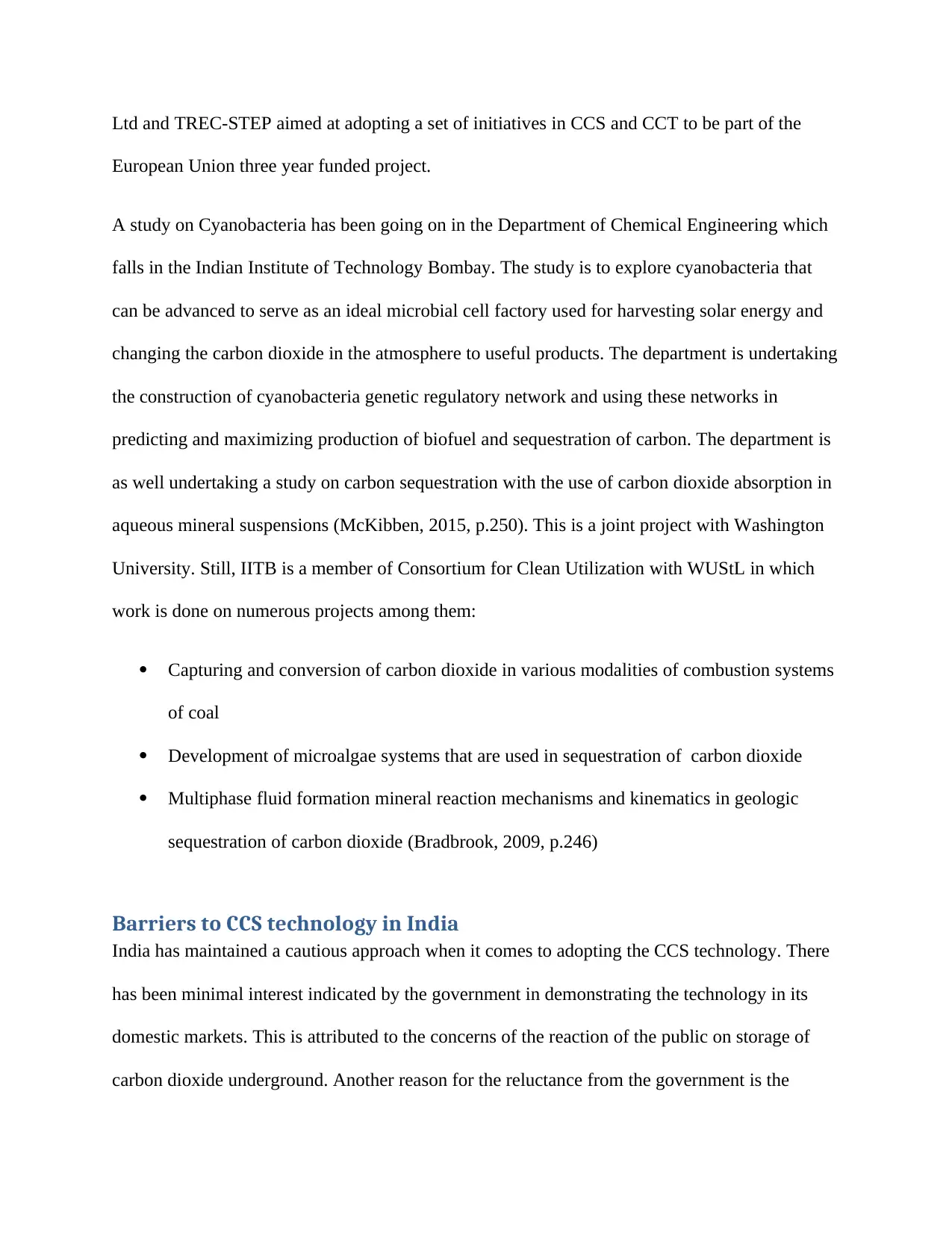
Ltd and TREC-STEP aimed at adopting a set of initiatives in CCS and CCT to be part of the
European Union three year funded project.
A study on Cyanobacteria has been going on in the Department of Chemical Engineering which
falls in the Indian Institute of Technology Bombay. The study is to explore cyanobacteria that
can be advanced to serve as an ideal microbial cell factory used for harvesting solar energy and
changing the carbon dioxide in the atmosphere to useful products. The department is undertaking
the construction of cyanobacteria genetic regulatory network and using these networks in
predicting and maximizing production of biofuel and sequestration of carbon. The department is
as well undertaking a study on carbon sequestration with the use of carbon dioxide absorption in
aqueous mineral suspensions (McKibben, 2015, p.250). This is a joint project with Washington
University. Still, IITB is a member of Consortium for Clean Utilization with WUStL in which
work is done on numerous projects among them:
Capturing and conversion of carbon dioxide in various modalities of combustion systems
of coal
Development of microalgae systems that are used in sequestration of carbon dioxide
Multiphase fluid formation mineral reaction mechanisms and kinematics in geologic
sequestration of carbon dioxide (Bradbrook, 2009, p.246)
Barriers to CCS technology in India
India has maintained a cautious approach when it comes to adopting the CCS technology. There
has been minimal interest indicated by the government in demonstrating the technology in its
domestic markets. This is attributed to the concerns of the reaction of the public on storage of
carbon dioxide underground. Another reason for the reluctance from the government is the
European Union three year funded project.
A study on Cyanobacteria has been going on in the Department of Chemical Engineering which
falls in the Indian Institute of Technology Bombay. The study is to explore cyanobacteria that
can be advanced to serve as an ideal microbial cell factory used for harvesting solar energy and
changing the carbon dioxide in the atmosphere to useful products. The department is undertaking
the construction of cyanobacteria genetic regulatory network and using these networks in
predicting and maximizing production of biofuel and sequestration of carbon. The department is
as well undertaking a study on carbon sequestration with the use of carbon dioxide absorption in
aqueous mineral suspensions (McKibben, 2015, p.250). This is a joint project with Washington
University. Still, IITB is a member of Consortium for Clean Utilization with WUStL in which
work is done on numerous projects among them:
Capturing and conversion of carbon dioxide in various modalities of combustion systems
of coal
Development of microalgae systems that are used in sequestration of carbon dioxide
Multiphase fluid formation mineral reaction mechanisms and kinematics in geologic
sequestration of carbon dioxide (Bradbrook, 2009, p.246)
Barriers to CCS technology in India
India has maintained a cautious approach when it comes to adopting the CCS technology. There
has been minimal interest indicated by the government in demonstrating the technology in its
domestic markets. This is attributed to the concerns of the reaction of the public on storage of
carbon dioxide underground. Another reason for the reluctance from the government is the
⊘ This is a preview!⊘
Do you want full access?
Subscribe today to unlock all pages.

Trusted by 1+ million students worldwide
1 out of 21
Related Documents
Your All-in-One AI-Powered Toolkit for Academic Success.
+13062052269
info@desklib.com
Available 24*7 on WhatsApp / Email
![[object Object]](/_next/static/media/star-bottom.7253800d.svg)
Unlock your academic potential
Copyright © 2020–2025 A2Z Services. All Rights Reserved. Developed and managed by ZUCOL.





